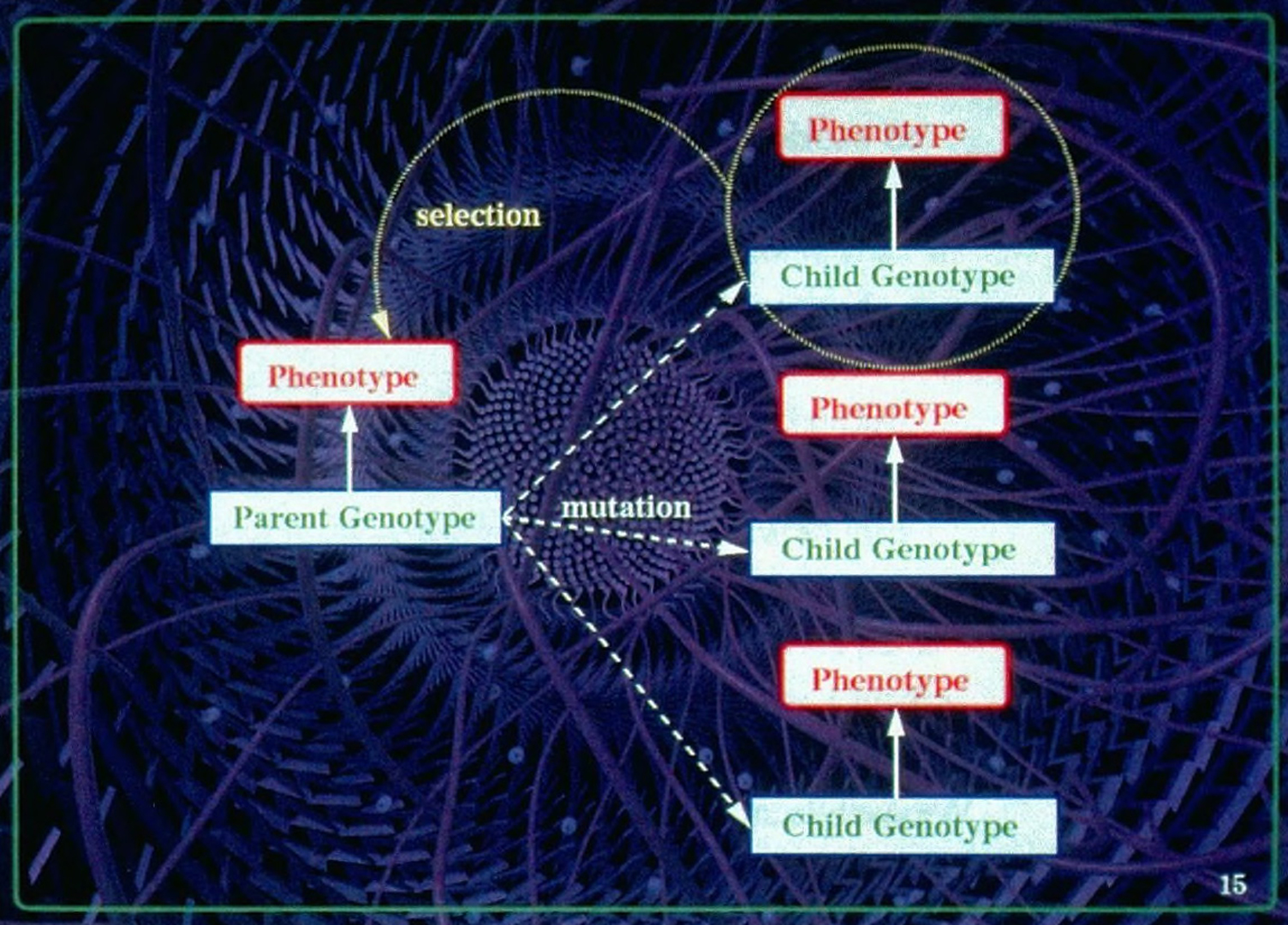“Turbulence: An Interactive Installation Exploring Artificial Life” by McCormack
Conference:
- SIGGRAPH 1994
-
More from SIGGRAPH 1994:


Type(s):
Entry Number: 08
Title:
- Turbulence: An Interactive Installation Exploring Artificial Life
Program Title:
- The Edge
Presenter(s):
Collaborator(s):
Description:
‘Who dwells In a realm, magical and barren, Without a before, and after, or a when… To be forever; but never to have been.”
From “The Enigmas” Jorge Luis Borges
“By the middle of this century, mankind had acquired the power to extinguish life on Earth. By the middle of the next century, he will be able to create it Of the two it is difficult to say which places the greater burden of responsibility on our shoulders.”
From “Artificial Life” Chris Langton
Turbulence is a menagerie of computer-synthesised forms based on the new science and philosophies of artificial life – the formation of life-like forms and processes from materials other than those found in nature. The work looks at poetic relationships between logic and purpose, and their relation to fundamental arguments about vitalism, destiny, and human consciousness.
Using “genetic” algorithms to produce artificial life forms whose shape, form, and behaviour represent “algorithmic ecosystems,” Turbulence develops and examines abstractions of life-like processes. Such processes are manufactured from a deterministic set of instructions applied millions of times by the digital computer. These synthetics are contextualised within the categorisation and classification of life by biological science. In many ways, the work is a type of futuristic natural history museum – a document of a type of life that exists only within the abstract space that becomes visible with the synergetic combination of mind and machine. Everything develops in a space somewhere between composition and adventure, between chance and destiny, between intent and invention.
The installation operates within an enclosed space and is decorated to (in some ways) resemble a natural history museum from the previous century. There are two main components inside the space: an interactive multi media program and a projected animation from a video laserdisc controlled via a small touch-screen interface.
Viewers enter an enclosed, darkened space. Along the walls are specimen jars that contain preserved examples of organic biological life: flowers, insects, organs, photographs of people, the components of living organisms. Many of these objects relate in some way to the video sequences on the disc. The jars are dimly illuminated internally. The overall impression created by the space is that of a strange natural history museum.
Farther along the entrance passage is a screen which runs the informational multimedia component of the work. Here, users can interactively evolve their own simple 3D organisms and learn about the processes and concepts of artificial life and its relation to the work on the disc. Sections also contain associated explanatory text, giving background information on the organisms, facts about reproduction, possible observations, and reactions. At this point, the user is introduced to the “logical” components of the work. What lies beyond is a poetic interpretation of these ideas.
Turning a corner, the viewer enters a dark space with a small plinth facing a projection screen. The plinth contains a touch screen, which controls the display of high-quality video segments from a laserdisc. Words and images float and spiral on the touch screen. Touching a word usually displays a section of animation on the projection screen. Collections of animated segments are grouped both thematically and by imaginary “species,” linked by their genetic relatives. It is important to remember that all the organisms are fictions, evolved by a software program during production of the project.
There is no start or end to the work, but as the user progresses with the interaction the software “learns” which areas the user is exploring and responds with inter-related options (i.e. the work tries to adapt to the personality and whims of the user). The nature of the interactivity allows different users to begin and end at any point within the work and quickly establish where they are within the structure.
Apart from its conceptual and thematic ideas, the presentation style is highly theatrical in nature. As has often occurred throughout the history of science, there is an apparent conflict between what is scientifically defined and what is undefinable within the consciousness of the individual. Science keeps coming up with ways to disprove our beliefs. The further down this spiral we travel, the less “human” we become.
The notion that a type of “life” can be synthesised by a machine and the potential of this current research has many important repercussions for our own evolution and our understanding of what life is. Despite all the “how,” paradoxically, science has got no closer to a “why.” These are the key issues that are examined here. Questions are not looked at from the purely mechanical or scientific view – the underlying context is the conflict between the logical view of life as the summation of discrete processes and the actuality of human consciousness.
References:
McCormack, J.P., Interactive Evolution of L-System Grammars for Computer Graphics Modelling, in Complex Systems: from Biology to Computation, David Green and Terry Bossomaier, eds., ISO Press, Amsterdam 1993.




